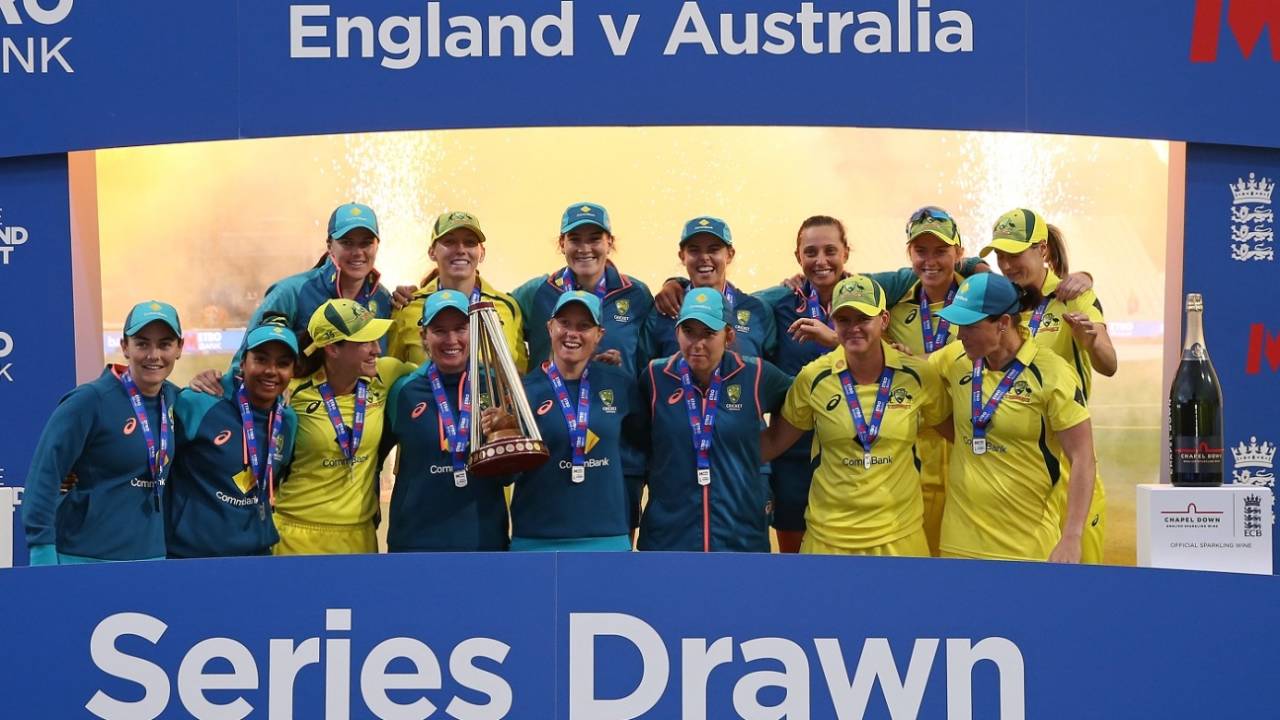Onus on Australia to take Women's Ashes to the next level
Success of dual series, hosted in major venues, lays down gauntlet to CA ahead of 2025 rematch
Valkerie Baynes
19-Jul-2023
Australia pose on the podium after retaining the Ashes, despite losing both white-ball series • Getty Images
England have thrown down a challenge to Australia ahead of the next Women's Ashes.
Not only did England push Australia to a draw in the multi-format series, but by hosting matches at major venues, the event received unprecedented public support with about 110,000 people attending the seven matches, which is more than three times as many as in 2019.
The Test, played at Trent Bridge, attracted more than 23,000 spectators across the five days, while each T20I - at Edgbaston, The Oval and Lord's - had crowds of around 20,000, while the ODIs peaked with more than 12,000 at the Ageas Bowl in between matches at the smaller venues of Bristol and Taunton either side.
Players from both sides lauded the dual "Ashes2Ashes" marketing campaign alongside the ongoing men's series and the use of bigger venues, which in turn offered better pitches.
Heather Knight, England's captain, said that despite the success of the Women's Ashes, it was too early to consider splitting off from the men's series with the Hundred setting another example of how marketing and playing in tandem could benefit the women's game in particular.
"The biggest thing that's helped this year is the fact that's been marketed as two Ashes, that's been brilliant," she said. "And the fact that the games have been put at the biggest grounds at the best times, not on a small ground on a Tuesday at 11 o'clock where you're fighting an uphill battle.
"Putting things together can work to gain that momentum and I think once you get the momentum then it can be a point where you split them, but I don't think that's yet. It's obviously been hugely successful this summer and I don't think I'd want to change that too much."
The next edition, in Australia in early 2025, won't coincide with the men's Ashes, which are scheduled for the 2025-26 Australian summer. One challenge Australia face in staging matches is the difference in stadium sizes, with most major venues holding a capacity of around 50,000 (the MCG holds 100,000) whereas Test venues in England generally hold between 20,000 and 30,000. Venues like Manuka, Junction and North Sydney ovals are significantly smaller and slightly more remote. That said, the WACA and Bellerive Oval, which will host South Africa Women over the upcoming Australian summer hold around 20,000 and could be used in a mix of larger and smaller venues for future series.
Alyssa Healy, Australia's stand-in captain on this tour, believes England setting an example for future series is a good thing.
"I think the ECB have put Cricket Australia under a little bit of the pump and said, 'over to you now and see what you can do,' so it's great for the game," Healy said.
"I keep saying and I have said for a long time, if you give us the opportunity in great venues with great wickets, we are going to give you a great show and that was proven throughout this series.
"People want to come when they know there's going to be good cricket played and I think both sides showed up wanting to be a part of that, so that was great and hopefully we see something similar in Australia."
Another challenge which might force a rethink of how the Women's Ashes, and increasingly popular multi-format series in the women's game globally, are played lies in the points system and weighting given to Test matches.
The fact that the Test was worth four points, double that of each white-ball game, led to the somewhat absurd situation whereby Australia managed to retain the Ashes despite losing both the T20 and ODI series 2-1. In other words, Australia drew the series and therefore take the trophy home despite winning three matches to England's four, because they won the Test.
Healy admitted that had left the overall result feeling "a bit dirty in a way", although Knight, who agreed the system could be overhauled by "the boffins", acknowledged her side had benefited from a similar scenario in 2013-14 when their victory in the Perth Test (then worth six points) was enough to retain the Ashes despite Australia winning the limited-overs legs.
She suggested making the Test worth an odd number of points so that there can be a clear winner rather than retention of the Ashes on a drawn series. But that still poses questions over whether the format which is played least often should carry more weight in women's series. The placement of the Test within the series also has implications for its importance to the overall result. In this edition, with the Test first, England found themselves in a situation where they needed to win five of the remaining six matches to win back the Ashes, which Australia have held since 2015.
Whatever happens next, it is clear there has been a shift on and off the field between these two great rivals. Over to you, Australia.
Valkerie Baynes is a general editor, women's cricket, at ESPNcricinfo
